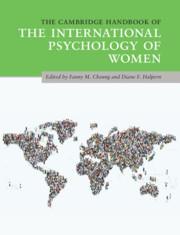Book contents
- The Cambridge Handbook of the International Psychology of Women
- The Cambridge Handbook of the International Psychology of Women
- Copyright page
- Dedication
- Contents
- Figures
- Tables
- Contributors
- Acknowledgments
- Section 1 The Underpinnings of Sex and Gender and How to Study Them
- Section 2 Developmental Perspectives of the International Psychology of Women
- Section 3 Cognitive and Social Factors
- Section 4 Work and Family Issues
- Section 5 Inequality and Social Justice
- 26 Girls, Boys, and Schools
- 27 Understanding Gender Inequality in Poverty and Social Exclusion through a Psychological Lens
- 28 Understanding Women’s Antisocial and Criminal Behavior
- 29 Sexual Assault
- 30 Intercultural Relationships, Migrant Women, and Intersection of Identities
- Section 6 Health and Well-Being
- Epilogue Some Final Thoughts and Take-Home Messages
- Index
- References
27 - Understanding Gender Inequality in Poverty and Social Exclusion through a Psychological Lens
Scarcities, Stereotypes, and Suggestions
from Section 5 - Inequality and Social Justice
Published online by Cambridge University Press: 20 July 2020
- The Cambridge Handbook of the International Psychology of Women
- The Cambridge Handbook of the International Psychology of Women
- Copyright page
- Dedication
- Contents
- Figures
- Tables
- Contributors
- Acknowledgments
- Section 1 The Underpinnings of Sex and Gender and How to Study Them
- Section 2 Developmental Perspectives of the International Psychology of Women
- Section 3 Cognitive and Social Factors
- Section 4 Work and Family Issues
- Section 5 Inequality and Social Justice
- 26 Girls, Boys, and Schools
- 27 Understanding Gender Inequality in Poverty and Social Exclusion through a Psychological Lens
- 28 Understanding Women’s Antisocial and Criminal Behavior
- 29 Sexual Assault
- 30 Intercultural Relationships, Migrant Women, and Intersection of Identities
- Section 6 Health and Well-Being
- Epilogue Some Final Thoughts and Take-Home Messages
- Index
- References
Summary
Poverty and social exclusion are a gendered phenomenon. They are rooted deeply in the stereotypes, biases, prejudices, and discriminations against women, especially those suffering from poor living conditions. Unfortunately, gender inequality is manifested in most, if not all, major life domains. It is therefore important to understand the gender aspect of poverty and social exclusion through a psychological lens. We begin this chapter by introducing the concepts of multi-dimensional poverty and social exclusion with a sketch of the gender disparities displayed in these areas. We turn next to several mainstream psychological theories which have attempted to investigate and interpret the relationship between poverty and gender inequality from the dispositional, motivational, cognitive, and behavioural perspectives. Finally, we evaluate the reliability, objectivity, and generalisability of the reviewed theories and studies and offer suggestions for future research.
Keywords
- Type
- Chapter
- Information
- The Cambridge Handbook of the International Psychology of Women , pp. 390 - 401Publisher: Cambridge University PressPrint publication year: 2020
References
Suggested Readings

Mary F. Zhang is a Senior Research Associate in the School for Policy Studies at the University of Bristol. Her main research and publication interests are in the impact of poverty and social exclusion on gender equality, resilience, and psychological and social well-being. Zhang was born in Shandong Province of China, which is also the home of Confucius and Mencius, and grew up there till age 18. She attended the Chinese University of Hong Kong for her BA in Psychology and the University of Cambridge for MPhil and PhD degrees. She spends most of her time in China and the United Kingdom.

David Gordon is a Fellow of the British Academy, Professor of Social Justice, and Director of the Townsend Centre for International Poverty Research at the University of Bristol. His main areas of research include the scientific measurement of poverty, social justice, and poverty eradication policies. Gordon was born in the East End of London, so he is Cockney, which means he was born within the sounds of Bow Bells. He has worked in Kawasaki, Japan, New Hampshire and Massachusetts, USA, and the Kingdom of Tonga (as well as in various locations in the UK). Gordon was born into a working-class family but has now become a middle-class university professor – a surprising and unusual transition in the UK. His father was an American and his mother was British, and he grew up in very multicultural parts of London. He studied Natural Sciences (Biological Sciences for undergraduate degree and Geological Sciences for PhD) but has worked for decades as a social scientist – another unusual transition.



